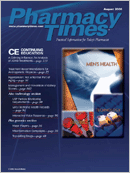Publication
Article
Pharmacy Times
ASTHMA WATCH
Exercise Techniques Reduce Need for Inhaler
Good news is here for individuals with mild asthma. A study, reported on-line in Thorax (June 5, 2006), found that exercises that concentrate on shallow breathing through the nose and nonspecific upper body exercises can help alleviate the need for a bronchodilator inhaler.
The researchers looked at the outcomes of 57 patients with mild asthma who were randomly assigned to perform 1 of 2 breathing techniques twice daily for 30 weeks. At the 16-week mark, an effort was made to lower the amount of inhaled corticosteroids the patients were taking for long-term control of their disease.
The study findings indicated that neither intervention had a major effect on quality of life, lung function, or constriction of the airways in response to asthma triggers. Yet, both types of exercise training were linked with an 86% reduction in the use of a beta-2 agonist reliever, and a 50% decrease in the dose of inhaled corticosteroids. Although breathing techniques may help patients with mild asthma, the researchers noted that presently no evidence favors shallow breathing techniques over nonspecific upper body movements.
Poor Communication Impedes Care
Inadequate physician-patient communication may play a negative role in asthma care. An international survey of 3500 adults in 16 countries found surprising results. The findings showed that 73% of asthma patients never or rarely discuss side effects with their physician. Furthermore, nearly 1 in 5 patients with the disease said they were unaware of the short-term side effects of the medication. Only 5% of physicians who prescribe treatments associated with possible side effects said they believe patients do not know about them, however.
National guidelines for asthma treatment call for written treatment plans that are discussed and provided by the physician to the patient. These plans are crucial to patients with moderate-to-severe asthma because they encourage a dialogue, according to the guidelines. Yet, research has found that written plans are often absent. In one study, for example, of emergency room visits involving >500 patients, <10% of patients with asthma who needed care had action plans for handling their condition.
Asthma Rates Go Up as Kids Age
A new study looked at the prevalence, incidence, and remission of children with asthma as they aged from 7 to 8 years to 11 to 12 years, and it examined the risk factor patterns for asthma during those ages. The research included 3525 children who participated in a study using an expanded International Study of Asthma and Allergy in Childhood questionnaire. The participants, who were reassessed annually, also had skin-prick tests for allergies at the study's onset and after 4 years.
Reporting in Allergy (May 2006), the researchers found, overall, an increase in the frequency of physician-diagnosed asthma from 5.7% at age 7 to 8 to 7.7% at age 11 to 12. Remission happened in about 10% of the participants yearly and was more likely in children with fewer allergies. Relapses were common, and unremitting remission was 5% a year. The strongest risk factor for current asthma was sensitization to any allergen, with no difference in genders. The researchers also concluded that a family history of asthma was the second strongest risk factor, and having resided with a cat was "significantly negatively associated with current asthma."
Program Scores Low for Inner-city Youth
An educational effort focused on inner-city children with asthma who used a nebulizer at home did not benefit the participants. The study assessed the value of an asthma education program that included 6 home visits and evaluated the use of a nebulizer and relief inhaler. The findings were compared with a more generalized approach involving 3 home visits.
For the 6-month study, 221 children were randomly assigned to one of the 2 groups. The study showed no major differences between the 2 groups in terms of home nebulizer practice, asthma attacks, emergency room visits, or hospitalizations. The average number of nonurgent care visits over the previous 6 months dropped from 3 at the study's onset to 2 at follow-up.
Of the 3 fatalities, 2 were in the intervention group, but one of the participants died before the education session started. The researcher noted in Archives of Pediatrics and Adolescent Medicine (June 2006) that the fatality rate (1.4%) was higher in the control group, compared with the national asthma fatality rate of 0.7 per 100,000 in children.
Lead investigator Arlene M. Butz, ScD, RN, said, "Over-reliance of young children with persistent asthma on quick-relief medication and undertreatment with preventive medications may be prevented by standard assessment of medication use by health care providers." She also suggested that regular review of pharmacy refill records and medication delivery technique may help find children with uncontrolled asthma.







